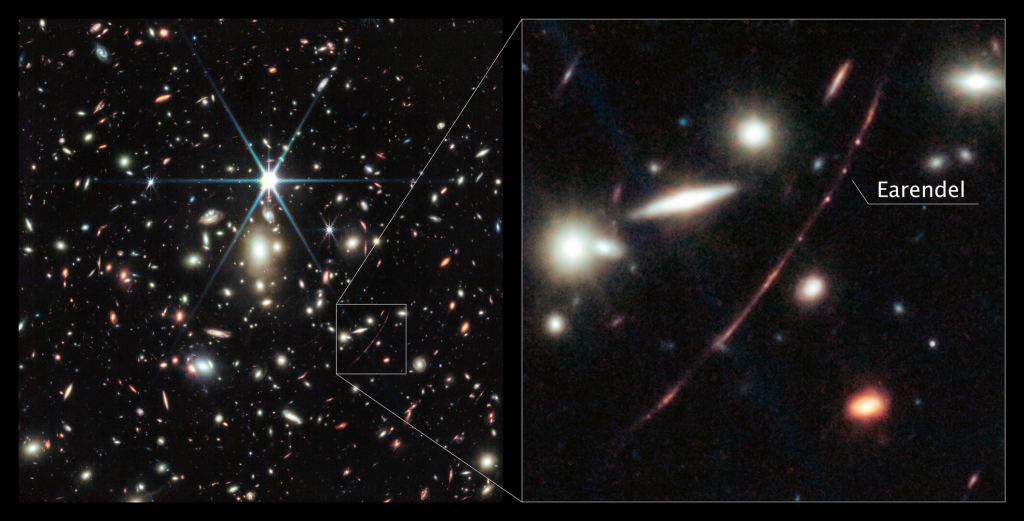JWST turns its gaze to the most distant star known: Earendel
- August 11, 2023
- 0
In March 2022, astronomers announced the discovery of the most distant star known in an image taken by the Hubble Space Telescope. They named it Earendel after the
In March 2022, astronomers announced the discovery of the most distant star known in an image taken by the Hubble Space Telescope. They named it Earendel after the

In March 2022, astronomers announced the discovery of the most distant star known in an image taken by the Hubble Space Telescope. They named it Earendel after the old English name for “morning star”. Now JWST’s Near Infrared Camera (NIRCam) and NIRSpec spectrometer have looked at the same star and have revealed more details about it.
Earendel looks like a big B-type star. This puts it evolutionarily in the main sequence, meaning it’s a hydrogen-burning star. Compared to the sun, it is twice as hot and a million times brighter. Astronomers suspect that this star, like many other massive stars like itself, may have a companion. However, they are so close to each other that we see them from such a distance (about 13 billion light-years) that it is difficult to distinguish them individually. But this star’s spectra (i.e. the colors of its light) imply a mate. Further studies using the magnification provided by gravitational lensing, along with more detailed observations with NIRCam on the JWST, will help them uncover their companion.
The light we see from Eärendel was first emitted by this star only about 900 million years after the Big Bang. The gravitational lens that discovered it magnifies Earendel 4000 times. Now astronomers want to know if this is one of the first generation stars to ever shine. If so, their spectra will show that its chemical composition consists mainly of hydrogen and helium. If it is a second generation star, then other elements will show the properties of its light. Other examples of such blue supergiants are Rigel and Beta Centauri.

Earendel’s JWST NIRCam image of the host galaxy (inset, right) and gravitational lensing galaxy cluster WHL0137-08 (left). Image features include both young star forming regions and older inhabited star clusters. In the image on the left, we see hundreds of small galaxies of various shapes, varying in colors from white to yellow to red. Some galaxies, often redder, appear distorted, strained or specular. Image credit: NASA, ESA, CSA, D. Coe (AURA/STScI for ESA), Z. Levey
The main galaxy of this star appears to us as a long crescent-shaped slab of light. This blur is caused by the gravitational lensing of the massive galaxy cluster WHL0137-08. The NIRCam view shows quite a bit of detail about this distant galaxy. There is a nursery where the next generation of stars are born. Some of these stars are quite young, not older than five million years.
The galaxy also contains star clusters that have a significant gap in their evolution. One of these clusters is about 10 million years old. It may still exist in the modern universe. The cluster gives astronomers some interesting clues about the globular clusters that populate our Milky Way today. Some may have formed at about the same time as the distant clusters on WHL0137-08.
Interestingly, the JWST image shows more details about the effects of lensing on the distant galaxy. Earendel itself stretches across the “ripple” created by the lenses. This is what it looks like apart from the blurry image of the main galaxy. In addition to viewing this NIRCam scene, JWST’s Infrared Spectrometer (NIRSpec) collected data. This gives astronomers more details about the exact distance to Earendel and its parent galaxy.
JWST discovered other distant stars with its infrared instruments. Airendel still holds the distance record. But many more explanations need to be made. Finally, astronomers hope to find one of astronomy’s Holy Grails: the first stars to shine.
These oldest objects may have appeared just 100 million years after the Big Bang. They were probably very large and extremely bright. As they began to emerge from the darkness of the cosmic dark ages, they heated and ionized the gases around them. As they evolved and died, they produced heavier chemical elements in their hydrogen-burning cores. When they died, they dispersed these materials into space, seeding a new generation of stars and eventually planets. The evidence for their lives and lifestyles will tell us a lot about all these conditions in the newborn universe, the distribution of matter (including dark matter) and the final formation of galaxies in early cosmic time. Source
Source: Port Altele
As an experienced journalist and author, Mary has been reporting on the latest news and trends for over 5 years. With a passion for uncovering the stories behind the headlines, Mary has earned a reputation as a trusted voice in the world of journalism. Her writing style is insightful, engaging and thought-provoking, as she takes a deep dive into the most pressing issues of our time.